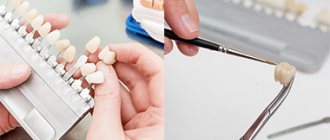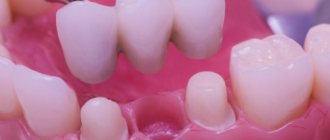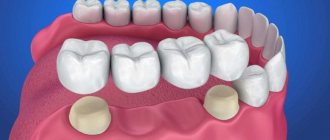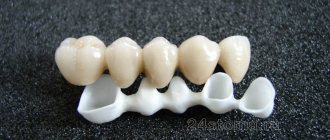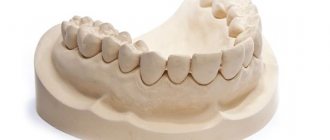Types and prices Cheap Rating of the best Free according to compulsory medical insurance
Find out on our website where you can get metal-ceramic crowns inexpensively and with high quality. The best dentists in Moscow. On our portal you can determine the best dental clinic where you can get this service, after you find which medical institution suits you best - read the reviews, see where this dentistry is located on the city map.
The cheapest price in Moscow for metal-ceramic crowns is 500 rubles. .
What is metal ceramics in dentistry?
By the word metal-ceramics we usually mean orthopedic structures - crowns and bridges made by spraying or casting ceramics onto a metal frame. This is a hypoallergenic, biocompatible material, which in most cases, with rare exceptions such as allergies, is not rejected by the human body. Such prostheses are used in dentistry mainly for prosthetics of chewing teeth, where aesthetics are not so important as function.
Which is better?
The question “Which metal-ceramics is better?” must be decided based on the service life and strength of structures based on various metals. In this case, the best one is, perhaps, the one that is made on a frame made of gold-platinum alloy. Such structures last up to 15 years. An alternative is zirconium dioxide crowns, which have an even longer service life of 20 years.
The most popular are cermets based on a gold alloy, which may also contain platinum and palladium, but gold still predominates in percentage terms. It is preferable to other types of structures due to the fact that gold is not oxidized by saliva and is one of the most biocompatible metals, that is, it is not rejected by the body.
Prosthetics
Metal-ceramic dental prosthetics can be used both in the frontal area of the smile and in the lateral areas.
Prosthetics of anterior teeth
It is possible to place metal-ceramics on the front teeth, but from an aesthetic point of view, such a solution would not be the best option. The fact is that in the frontal zone the transparency of the tooth enamel is greater than in the lateral zone, so the metal frame can be seen through the ceramic coating. Therefore, for prosthetics in the smile area, as a rule, solid ceramics or ceramics on a zirconium frame are used. However, if the patient wishes, metal-ceramics can still be installed on the front teeth. Moreover, if dentures are carefully and regularly cared for, their service life on the front teeth, according to patient reviews, can be more than 10 years.
Prosthetics of chewing teeth
The most popular are metal-ceramics for chewing teeth in the lateral regions, where strength is more important than appearance. However, it cannot be said that such crowns or bridges on chewing teeth look unaesthetic. These dentures closely imitate the structure and shades of natural dental tissue. But their main advantage is still their ability to withstand any chewing load.
Indications
In some clinical cases, it is impossible to restore a tooth with a filling. It is also difficult to attach the crown to the remaining dental tissue. Many clinics decide to remove these remains and offer implantation. In our dentistry, we fight to the last to preserve the tooth.
Significant destruction of chewing teeth due to caries or injury is not a reason to completely remove it. Even if only the root remains, it can be used as a basis for installing a core inlay with a metal-ceramic crown. The tab will be a strong link between the root and the crown. This orthopedic design will allow you to completely restore chewing functions and the appearance of the tooth.
Making an appointment does not oblige you to anything, you can cancel your appointment at any time
Make an appointment
An important condition is that the tooth root must be intact, and there must be no inflammation in its tissues. It is also necessary that the walls of the root canals have sufficient strength, and the root itself is of sufficient length.
| The price of a metal-ceramic crown with an inlay is less than the same crown installed on an implant - an artificial tooth root. Therefore, if indicated, our patients can save significant money. |
Metal ceramic prostheses
Metal-ceramic dentures are frames made of non-precious, semi-precious or precious metal onto which special dental hypoallergenic ceramics are sprayed or poured (depending on the manufacturing method). The material is able to reproduce the color and structure of natural dental tissue, while it does not fade or absorb dyes. The following types of prostheses exist.
- Crowns.
They are used mainly for prosthetics in the lateral zone to restore teeth that have been destroyed by more than 2/3. Read more in the article. - Dental bridges.
Serve to replace several missing teeth in a row. The most reliable bridge structures consist of two crowns and two artificial teeth between them. - Clasp dentures.
Removable structures in which the arch (clasp) and the frames of the crowns attached to it are made of metal. They are used when fixed prosthetics are impossible for one reason or another.
When is the best time to get a metal-ceramic crown?
Metal ceramics are durable, look natural, and are affordable. It is used for prosthetics in the following cases:
- Restoration of a damaged tooth. When making prosthetics, the remaining tissues are trimmed to prepare the base, the crown is made according to its shape;
- Replacement of a missing unit. For this purpose, implantation is performed. The metal-ceramic structure is installed on the implant after its engraftment. An implant replaces a tooth root, and a prosthesis replaces a tooth crown;
- Replacement of a missing tooth or teeth in case of contraindications to implantation. To do this, the existing teeth are prepared, which will be supporting in the bridge structure, and crowns will be added in the area of missing teeth. This way the whole structure will be uniform.
- Installation of prostheses. Metal ceramics are used in the manufacture of removable, conditionally removable, non-removable structures (bridge-like, clasp and others).
When implanting and prosthetics using metal-ceramics, it is possible to replace both individual units and entire groups of teeth.
Sign up for a free consultation
Pros and cons of metal ceramics
Many patients who decide to undergo prosthetics are concerned with the question: “Are metal-ceramics harmful?” If all manufacturing and installation standards are observed, harm is minimized and practically eliminated. Modern materials do not contain any toxins. However, it is worth remembering that different types of materials may behave differently in the oral cavity. Thus, in the case of chromium-nickel alloys in the crown frame, allergies to nickel are common, and some base metals can oxidize over time under the influence of saliva. Among the advantages of metal-ceramics are high strength and long service life, and the disadvantages are the possibility of exposing the metal frame when the gums recede (the exception will be crowns made of zirconium dioxide), the translucency of the frame through the ceramics and the need for rather strong grinding of living tooth tissues under the crown, up to depulpation of the living tooth tooth without direct evidence.
Strength
Currently, metal-ceramic dentures, both single and bridge-like, are in most cases used on teeth that have a significant chewing load. Although until recently they were the undoubted leader, regardless of what types of dental prosthetics were used. Ceramic crowns, on the contrary, were not popular for a long time due to the increased fragility of the structure and therefore were used only for prosthetics of the frontal group of teeth. However, with the advent of frameworks made of zirconium dioxide or aluminum dioxide, more and more dentists and patients prefer these modern materials for prosthetics of both chewing and, in some cases, anterior teeth.
It is worth noting that the excellent strength of metal-ceramic prosthetics can negatively affect the surface of the teeth intersecting with them and lead to their excessive abrasion. At the same time, metal-free dentures have a hardness coefficient close to that of natural teeth, which makes it possible not to injure opposing teeth.
Allergy
The ceramics used to make crowns are absolutely hypoallergenic, but the metals used in the frame can in rare cases cause an allergic reaction. Symptoms of an allergy to metal ceramics are a burning sensation in the mouth, in the area of both the gums and the tongue, a metal bite, swelling of the gums in the area of contact with the crown and swelling. If the phenomena described above are observed after installing a crown, you should consult a doctor. In such cases, it is recommended to replace the metal-ceramic with an all-ceramic crown.
Life time
One of the saddest misconceptions of patients is that a metal-ceramic crown does not require replacement and will last the rest of its life. Unfortunately, this is not the case and its service life is limited. On average, a metal-ceramic denture can last 10–12 years if the frame is made of an alloy of base metals, and 15 years or more if a gold-platinum alloy is used. However, it is worth considering that the prosthesis must be made strictly according to individual casts, and the patient, when wearing such a fixed or partially removable structure, must follow all care recommendations. The warranty on metal-ceramics lasts on average from one to three years, depending on the material used to make the frame. At the same time, the warranty conditions imply that the crown will maintain its integrity and will not be destroyed by mechanical stress within a specified period, while the most common cause of crown loss is secondary caries that develops at the junction of the tooth and the crown. In order to avoid such situations, it is necessary to regularly undergo preventive examinations and promptly replace old orthopedic structures with new ones. Remember: the denture has a service life, failure to comply with which can lead to tooth loss.
Color
The ceramics used to make metal-ceramic crowns allows you to imitate the color and structure of natural enamel, making the prosthetic tooth as similar as possible to the patient’s neighboring, natural teeth. The color is selected according to the Vita scale, it does not fade or change over time, since, unlike natural enamel and composite materials (for example, fillings), ceramics do not absorb colorants from food and drinks, so bleaching is not required. If you think it’s time to whiten the metal ceramics installed in your mouth, most likely you need to visit a hygienist to remove stained plaque.
Metal ceramics or ceramics?
If you decide to resort to dental prosthetics using crowns or bridges, then sooner or later you will face the question: “Which is better - ceramics or metal-ceramics?” They differ in their aesthetic and functional properties. Metal-ceramic dentures are more durable, but have significant aesthetic disadvantages, which play a big role in restoring teeth in the smile area. Therefore, for prosthetics of the anterior dentition, orthopedic structures made of solid ceramics will be the preferred option. However, it is worth considering that most ceramic dentures are very expensive. In the case when chewing teeth are restored, metal ceramics are quite acceptable, since its aesthetic defects are invisible in the lateral sections.
Metal-plastic
Modern dentistry offers many different options for making crowns, the main difference being the materials used to make the frame and the anatomical shape of the tooth. Some materials are more expensive, others are cheaper, but the quality of crowns, as you might guess, directly depends on the price, since the most durable and aesthetic designs are made from more expensive materials. To the question: “Which is better – metal-ceramics or metal-plastic?” The answer is clear, of course, metal ceramics. Despite the fact that modern dental plastic is of decent quality and hypoallergenic and, just like ceramics, is able to imitate the natural color of teeth, it still loses in many respects, so the choice - metal-plastic or metal-ceramic - is decided in favor of the latter. Plastic is inferior to ceramics both in strength and in its ability to imitate natural enamel. Therefore, plastic in modern dentistry is used exclusively for the manufacture of temporary crowns, those that the patient wears while permanent structures are made in the dental laboratory or while the implant is healing. Making permanent crowns from plastic, and even on a metal frame, is absolutely unprofitable, the service life of metal and plastic is different, and their connection is not justified.
...or metal?
Also today, all-metal crowns are available to patients, but this is the most unaesthetic type of orthopedic structures, which, unlike metal-ceramics and ceramics, are in principle unable to imitate a natural tooth in anything other than anatomical shape. However, metal crowns are noticeably cheaper than metal-ceramics, but inferior to it in most respects. In addition, metal structures can cause increased wear of the teeth with which they come into contact.
Metal ceramics or zirconium?
We have already discussed above how metal-ceramics differs from ceramic-coated zirconium. If you are faced with a choice: zirconium dioxide or metal-ceramics, then in the case of prosthetics of the front teeth, the advantage, of course, is on the side of ceramic crowns on a zirconium frame. As for the teeth in the chewing zone, it is not so important; they are not inferior to each other in strength, and the aesthetic side in the lateral section is not as important as the functional one.
What is the role of the stump tab?
This is an orthopedic structure that is installed in the treated dental canal. It becomes part of the tooth root and is able to withstand significant chewing load. We use core inlays, which are made in the laboratory according to the individual parameters of each patient’s root canals. Thanks to this meticulous approach, the restored teeth are durable.
Any inlay consists of an internal canal part (it is placed in the tooth root) and an external part - a crown imitating a tooth is attached to it. The design for a single-channel tooth is monolithic, and for a multi-channel tooth it is collapsible.
Making an appointment does not oblige you to anything, you can cancel your appointment at any time
Make an appointment
Installation process
Now let's talk about how cermets are installed.
- First of all, you need to undergo a diagnosis.
- Dental preparation procedure. Contrary to popular belief, installing metal ceramics on a living tooth is quite possible. However, in most cases there is a need to depulpate the tooth.
- After this, the orthopedic doctor will be able to take impressions of the ground teeth necessary for the manufacture of individual structures.
- Fixation of the prosthesis.
Many patients are interested in how teeth are ground for metal-plastic - dentures with a metal frame and a plastic coating on top. The preparation technique is the same as when installing metal-ceramic structures, but the tooth undergoes much more significant grinding due to the massiveness of the metal-plastic structures.
If you decide to install dentures, choose trusted dentists here.
Features and advantages of installing metal-ceramic crowns
A turnkey metal-ceramic crown is a full range of dental work, therefore the price for installing a turnkey metal-ceramic crown in Moscow varies within different limits. In our dental center you can install dentures quickly and inexpensively - if you need a turnkey metal-ceramic crown, the price varies between 4,800 - 12,000 rubles.
We offer only high-quality metal-ceramic crowns from reputable manufacturers that comply with genuine certificates. Our doctors have the latest technologies for installing dentures and all the necessary skills of modern dental prosthetics - if your choice is metal-ceramics, the promotion in our dental center is for you! Offers:
· no hidden fees;
· transparent pricing for prosthetics;
· reasonable cost.
Installing a turnkey dental crown in Moscow includes the work of a doctor and the use of the necessary dental materials. After diagnosis, various additional manipulations may also be needed. A preliminary consultation with a Mane Clinic orthopedist is carried out, a panoramic image of the jaw is taken, hypoallergenic materials are selected in our dentistry - when a metal-ceramic crown is needed, the promotion will help make dental prosthetics at the lowest cost.
After drawing up a dental treatment plan, you can begin installing a turnkey crown - our dentistry has a promotion for metal-ceramic crowns. Thanks to her, dental treatment will be carried out at the lowest cost. If you need high-quality dental prosthetics and a metal-ceramic crown, a promotion in Moscow will allow you to save money on treatment and metal-ceramics.
View treatment results
Grinding of teeth
In prosthetics, there are several methods of preparation for metal ceramics. Tooth grinding can be done in two ways, described below.
Metal-ceramics with ledge
The orthopedist, when grinding the dental tissues, forms a circular ledge along the lower edge, which avoids contact of the metal frame with the gums, and, as a result, minimizes the risk of swelling, irritation, bleeding and allergies. With such turning, it is possible to use metal-ceramics with shoulder mass to improve aesthetics. The shoulder mass is applied in the area of the ledge under the metal ceramics and serves to hide the strip of gray metal that shows through the enamel at the base of the crown. Installation of metal-ceramic with a shoulder and shoulder mass usually costs more, but these costs are completely justified and allow you to avoid many problems with dentures. In addition, grinding for metal ceramics with a shoulder extends the service life of the crown by several years.
Turning without shoulder
This is an outdated method that was previously used to install stamped steel prostheses or metal-plastic crowns. However, some doctors still use it for preparation under metal ceramics, which leads to negative consequences. Preparing a tooth without a shoulder does not provide enough space for a crown, so the gum contours are compromised. The outer perimeter of the artificial crown is larger than that of a natural tooth. As a result, a space is formed between the metal ceramics and the gum where plaque accumulates, the exposed edge of the denture looks unaesthetic, and the structure itself constantly injures the surrounding soft tissues. In this regard, if a doctor grinds teeth for metal-ceramics without a ledge, the crown will need to be replaced after 5-6 years.
Advantages and disadvantages of metal ceramics
- Identity of metal-ceramic crowns to natural teeth. They can be used to bite and chew solid food, and the high aesthetic qualities of the crowns allow them to be installed even on the front teeth.
- Hygiene. Much less stone and microbial plaque settles on the surface of metal ceramics than on natural enamel and metal crowns.
- Durability. If a crown is made using modern techniques and from high-quality material, it can last 12-15 years. Throughout this entire period, the crown “stays” exactly on the tooth, caries does not develop under it and no changes occur in the gum.
Metal-ceramics is not without its disadvantages. So, before installation, the abutment tooth must be ground and depulped. Carrying out these manipulations by a non-professional is fraught with the development of pulpitis. Some clinics offer fairly low prices for metal-ceramic crowns without shoulder masses. Such crowns look somewhat unaesthetic, because... There is a dark line along the edge of the prosthesis. In Dentistry on Amurskaya, crowns are used only using shoulder masses. The shoulder mass protects the gums from contact with metal and significantly increases the aesthetic properties of the crown.
Care
Daily oral hygiene after installation of metal ceramics is no different from usual. Care involves brushing your teeth in the morning and evening, and, if possible, after each meal. In this case, it is necessary to follow the cleaning rules: the sweeping movements of the brush should be directed from the gums to the cutting edge; the care of metal-ceramic teeth should be completed with dental floss, and ideally, treatment with an irrigator. If you are interested in the question of how to clean metal ceramics, then everything is simple: with the same thing you use to clean your own teeth, that is, with a soft brush that does not harm your gums, and a paste that your dentist will help you choose based on your individual characteristics of the oral cavity. If during cleaning or at any other time you feel that your teeth under the crown hurt, contact your dentist immediately; secondary caries may have developed under the denture, or the carious cavity was not treated thoroughly enough.
How do MRI and metal-ceramics compare? We hasten to reassure you: metal-ceramic crowns do not deform or move under the influence of a magnetic resonance imaging scanner, however, they can provoke an image defect in the image, so always warn the doctor who prescribes an MRI for you.
Situations are different, and sometimes restoration of metal ceramics is required. This occurs when the crown is mechanically damaged. If metal ceramics break off in your mouth, the orthopedist will first of all assess the extent of the problem - how large a piece was broken off. And here he is primarily interested in whether the metal frame is exposed or not. The fact is that restoring a minor chip is quite possible, including using composite materials. At the same time, restoring metal ceramics in the oral cavity when the frame is exposed is, in most cases, no longer possible. In such a situation, it will most likely be necessary to remove old structures and install new ones. Also, do not forget that timely replacement of metal-ceramics will help to avoid unforeseen problems, such as falling out crowns or their splitting.
Prosthesis service life
Metal-plastic dentures with an acrylic base are used at the first stage of prosthetics during implantation with immediate loading. The minimum period of wearing them is six months to a year, during which time the implants take root. However, such a prosthesis will last about 3-5 years. Therefore, it will be possible to replace it with a structure made of more practical and durable materials - fiberglass, ceramic composite, zirconium or metal-plastic - after this period has expired, that is, after the loss of aesthetics or breakage of the prosthesis.
More examples
Read detailed instructions for caring for the oral cavity and dentures after dental implantation >>>
Comparison of metal-plastic and ceramic composite
At the Smile-at-Once clinic, when performing one-stage dental implantation with immediate loading (basal complex and All-on-6), two types of prostheses are used, which are installed 1-3 days after implantation. This is directly metal-plastic, as well as a modern photopolymer ceramic-composite prosthesis. We presented a comparison of the two types of structures in the table:
| Photopolymer ceramic composite | Metal-plastic | |
| Original aesthetics | high | relatively high |
| Preservation of appearance during operation | is maintained at a high level - the material does not absorb dyes and does not darken if hygiene is observed | during the year – high, then – decreases: the color of the crowns changes, plaque accumulates |
| Possibility of repair | possible directly in the oral cavity | possible directly in the oral cavity |
| The need for re-prosthetics (stage II) | Not required | required at least six months to a year, or after the prosthesis breaks |
| Clinic guarantee | 5 years | 1 year |
| Life time | from 10 years or more | no more than 5 years |
| Cost of basal implantation together with prosthesis for one jaw | from 400,000 rubles | from 250,000 rubles |
Guarantee
As with any other types of dentures, each clinic provides a guarantee for metal-ceramics for teeth. Of course, its duration is short, and how long the guarantee for metal-ceramics lasts depends mainly on the decision of the management of dentistry. What kind of warranty is usually provided? This is a period of one to three years during which you can see a doctor for free repairs to your prosthesis. Considering that structures made from this material are recommended to be replaced after 5-7 years, such a guarantee can be called acceptable.
